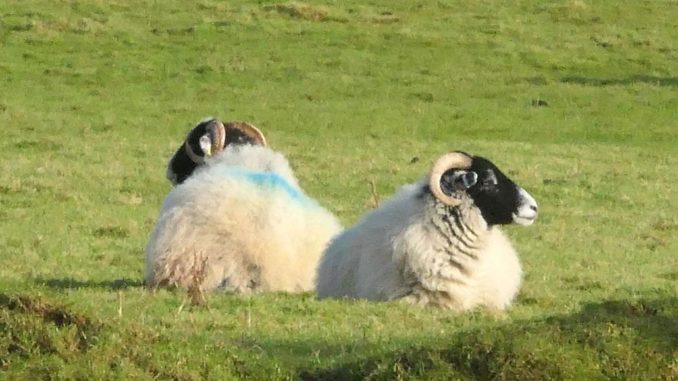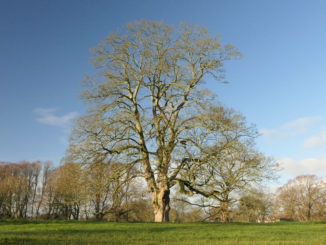
© DMG 2021
Imbolc
This celebration of light and hope marked the early signs of spring and is one of the key occasions in the Celtic calendar, marking the transition from winter to spring. Widely observed in Ireland, Scotland, and the Isle of Man, it is linked to the Goddess Brigid.
With the appearance of fresh shoots comes the promise of new growth. It is said to mark the beginning of the lambing season, and no doubt there would be blessings for agricultural tools and seeds.
The growing power of the sun meant greater daylight and warmth, which was encouraged by the lighting of candles and bonfires, with fire, purification and healing being of great importance. After reflecting on the future during the dark days of Yule, Imbolc is a time when inspiration and creativity begin to coalesce, and our plans take form. It is all about preparation and first steps. And a good spring clean is always a reliable first step.
Much of what we know about Imbolc and Brigid’s Day was recorded by writers and folklorists from the 18th to mid-20th centuries, and while many customs have faded away, it is still observed in some places, with Ireland seeming to be where it has endured the most.
Today, many people who make a point of observing Imbolc have various rituals which include things like blessing and planting seeds; leaving out offerings of cream and honey for Brigid; decluttering and organising living spaces; throwing open windows to properly air the home; lighting candles; take a ritual bath using milk or cream; lighting a fire; and formalising plans for any projects which are about to be put into action.
I must admit, it is not a festival I was particularly familiar with beyond the notion of ‘spring cleaning’, and as a child that was never an activity which excited me. However, like all these ancient festivals, there are events in nature that take place around us which we observe and mentally ‘tick off’ that mirror what our ancestors did.
It’s not certain where the word Imbolc originates. One claim is that it comes from Old Irish I mbolc’ which means “in the belly” and references pregnant ewes. An alternative is the Old Irish imb-fholc, which means to “wash/cleanse oneself”, referring to a ritual cleansing. A third option is the suggested in the 10th century Cormac’s Glossary which identifies it as oimelc, or “ewe milk”, but many scholars consider this as a folk etymology.
Pronunciation will vary depending on where you’re from, with ‘im-bullug’, ‘im-bulk’, ‘imb-olc’ and ‘im-molc’ being the most common.
On February 2nd, the Irish have Lá Fhéile Muire na gCoinneal’ and the Welsh have Gŵyl Fair y Canhwyllau which both refer to “feast day of Mary of the Candles”, so it is very common for Imbolc to be conflated with Candlemas.

© DMG 2021
Like many ancient festivals, the date of Imbolc is hard to pin down with any certainty. It is generally said to take place midway between Yule and the spring equinox.
Having Celtic origins, it begins at sunset on one day, and ends at sunset on the following day. Some say this is from January 31st through to February 1st, while others claim it is from February 1st through to the 2nd.
I naturally aim for precision and accuracy (although I am always trying to force myself to be content with ‘close enough’), so those of you who are mathematically minded might be interested to know that I calculated that there are 89 days from Yule to the equinox this year, and 45 days after Yule is actually February 4th.
In some ‘modern traditions’ they determine the date ‘when the sun reaches 15 degrees Aquarius’, which marks the actual mid-point between the winter solstice and spring equinox in astronomical terms. But to be honest I really don’t know what ‘15 degrees Aquarius’ means, and I’m not especially interested in ‘modern neopagan’ stuff. It is the old myths and habits which I find more enlightening.
One thing is for certain though, the occasion has been marked for a long, long time. There are tombs in Ireland which have passages aligned with the sunrise on Samhain and Imbolc. One is the Hill of Tara, which is 5,000 years old. I felt quite smug when I discovered that the entrance and passageway are directly lit by the rising sun on November 8th and February 4th, marking both the beginning and end of winter.
But for those of us who don’t have a Neolithic monument to hand, I think the common-sense approach of our ancestors is the best way to go, where it is most likely that the date was fluid, and they celebrated when they saw the signs of the changing seasons, such as lambs, snowdrops, primroses, dandelions, and blackthorn blossom. These would be the signs that most people would use to judge the shift in the seasons and they could easily vary by a fortnight before or after the start of February.
‘Close enough’.
Imbolc has also traditionally been a time of weather divination. I strongly suspect this keen interest would be down to the importance of planting your crops at the right time. With winter stocks dwindling, it was crucial to begin the new farming season at the best time but because of our notoriously dodgy climate there was always the risk that planting would be done too soon. Deciding if winter has truly gone, or whether you need to prepare for a prolonged spell of cold, wet weather could mean life or death in small communities.
My Granny grew up on a wee croft on the east coast of Scotland and she was fond of reciting this rhyme on 2nd February:
“If Candlemas Day be dry and fair,
The half o the winter’s to come and mair;
If Candlemas Day be wet and foul,
The half o the winters gane at Yule.”
Her father worked the land, so I imagine this rhyme would have been something she absorbed in childhood when the farm started to come back to life.
Another Scottish Gaelic proverb about the day is:
“Thig an nathair as an toll
Là donn Brìde,
Ged robh trì troighean dhen t-sneachd
Air leac an làir.”(“The serpent will come from the hole
On the brown Day of Bríde,
Though there should be three feet of snow
On the flat surface of the ground.”)
This second saying is about observing serpents emerging from their dormancy, and there is similar wisdom regarding badgers emerging from their winter dens. No doubt this has links to Groundhog Day in America, where they have turned ancient and useful country lore into a gloriously gaudy ‘Americanised’ celebration. Mind you, at least they still mark the day. These days the occasion largely passes by unnoticed in the UK.
The primary figure associated with Imbolc is the goddess Brigid who is recognised as a queen, mother goddess and fertility goddess in many European tribes. Depending on where you live the spelling of her name may vary (Bridget, Brighid, Brighde, Brig or Bride) as well as it’s supposed meaning (‘Bright one’, Bright/fiery arrow’, as well as ‘the exalted one’).
Primarily she is a goddess of fire, but she also represents healing, regeneration, poetry and smithcraft. She brings fertility to the land and the people, and so is closely linked to midwives and the new-born. She is also invoked to protect homes and livestock.

© DMG 2021
There is a wide variety of symbology associated with Brigid: the snowdrop, for the first gift of spring; sheep, as her festival is at the beginning of lambing season; the swan, representing loyalty and fidelity; and the flame, including the sun and the hearth.
It was said that she would visit households on Imbolc eve, and those living there would be blessed. Families would enjoy a special meal on Imbolc eve such as colcannon, dumplings or bannocks. Hospitality would be laid on, ranging from setting some food aside or even making up a bed for her. Some would leave items of clothing outside to receive her blessing, in the belief that they would be imbued with powers of protection or healing.
She was so loved by the people that the Christian church adopted her and reinvented her as Saint Bridgit. She supposedly wove the first piece of cloth in Ireland and used it to create healing threads which retained their power for centuries. Many healing springs and wells are named in her honour.
There are numerous traditions involving a doll-like representation of Brigid—called a Brídeóg—which is made of rushes or reeds and dressed in bits of cloth and/or flowers.
A simple tradition is to place the Brídeóg into a ‘Bride’s Bed’ to bring fertility and good fortune to the home.
In Ireland and Scotland, the Brídeóg used to be carried in procession around the town by girls and young women who were singing hymns to Brigid. All the girls would wear white, signifying purity and youth. In some regions only unwed girls could carry the Brídeóg, while in others boys joined in as well. Every house would be visited, where they would receive either offerings of food or more decoration for the Brídeóg. Afterwards, a feast would be held in a house with the Brídeóg in place of honour before it was put to bed with lullabies sung to it.
Sometimes, instead of fashioning a Brídeóg, a girl would take on the role when traveling house to house, wearing a crown and carrying a shield which were both made from rushes or reeds.
Children in Ireland also used to go door-to-door asking for pennies for ‘poor biddy’, with this money given to the poor. This tradition may have faded away around the mid-20th century, but Brigid’s Day Parades have been revived in Killorglin, County Kerry, where they hold an annual ‘Biddy’s Day Parade’ packed with folk music, singing, dancing and a torchlight procession.

© DMG 2021
In Ireland especially, a simple way to mark Imbolc was by crafting a Brigid’s cross. They were usually made of rushes or reeds and fashioned into a cross with four arms of equal length, although occasionally a three-armed version will be seen. The cross is known as a fire wheel cross and is almost certainly a variation of the ancient ‘solar cross’. These are usually drawn in a circle and chiefly represents the four seasons, although is also said to signify the four classical elements of earth, air, fire and water.
A Brigid’s cross is very simple to make. Start with two reeds crossed, then work around adding reeds (which have been bent in the middle) to build up the woven effect. Once you’re finished, reeds or ribbons can used to tie the arms together, and often items associated with Brigid is incorporated, such as swan feathers, etc.
Hung over doors and windows to welcome Brigid, these crosses were a talisman against a range of troubles such as fire, illness and evil spirits. They were usually left hanging in place until the next year when a fresh cross was fashioned to replace it.
So that’s a quick tour of Imbolc. If you don’t fancy going the whole hog and lugging a Brídeóg round your neighbours’ houses, you can always just appreciate the snowdrops and lambs you see out on a walk. You could visit a well or spring and part with a few pennies as an offering for good fortune. And no doubt you’ll give your house a good airing and do a bit of spring cleaning before cracking on with whatever projects you’d like to accomplish this year. On reflection, I probably did all that without realising it as a child.
Except for the ‘spring cleaning’ bit. I never did that.
Next up: The spring equinox, or ‘Ostara’.
© Carvetii 2020
The Goodnight Vienna Audio file
Audio Player



